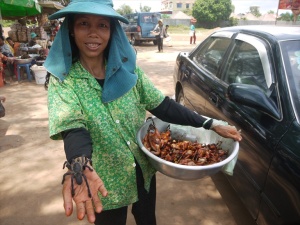I generally like my bugs to remain at a distance. That especially applies to arachnids, which I prefer far, far away from my person or, maybe behind glass in a terrarium at some zoo’s insect house.
But some Cambodians like their spiders up close and personal, preferably on a plate, deep fried and steaming, with competing but oddly complementary textures — crispy legs balancing the more fleshy, gooey abdomen.
Cambodians have a higher threshold than us weak-stomached westerners when it comes to food – especially the once-living kind – and its presentation. While we like our meats shrink-wrapped and filleted, usually bearing little resemblance to the original animal, Cambodians are brutally honest about where their protein comes from – likely in part is because refrigeration is a luxury many can’t afford so fresh meat means keeping it alive as long as possible before chowing down.
Here you see big slabs of bloody meat lying out in the markets under the tropical sun, or tables piled high with severed pig heads and hooves, baskets full of gasping fish waiting for the relentless cleaver of a market woman doing her thing on the pavement inches away from passing scooters and pedestrians. Often you’ll see whole bodies of steer driven through with a spit and left roasting on busy intersections. Last year, I was offered frog-kabob by a roadside seller. I politely declined.
This year, on a weekend trip to the town of Kompong Cham, about two hours by car north of Phnom Penh, my friend and I noticed we were passing through Skuon, Cambodia’s fried spider capital. I lobbied for a stop, to notch up the food revulsion response. Pig heads and piles of mysterious innards had become old hat.
Skuon has learned to capitalize on its notoriety. The little town has erected a sign that has a sculpture of two big spiders at its base. We pulled into a little market a little further down the road and the driver pointed to our left. Sure enough, there was a woman carrying a bowl piled high with a blackish, leggy mass – tarantulas, ready for the eatin’.
Of course, the sight of two westerners getting out of a car and gawking brought over a swarm of sellers, mostly young girls, some of whom spoke surprisingly good English. While I was snapping away at the bowl of crispy critters, and the fried crickets nearby, a girl’s voice behind me said, “Here, do you want to hold it?” I turned around and inches from my face was a live one, a tarantula taking up most of her palm, starting a journey up her wrist.
I erupted with a “Whoa! No, no, no thanks” while simultaneously jumping back about a foot. “But they can’t bite, look,” she said, turning it over and showing how the tips of the spider’s fangs had been cut off. The spider then made its way up to her neck while she tried to convince me to take it off her. My courage failed me. I bought some bananas and pineapple from her. The spider and I remained physically unacquainted.
Not every Cambodian likes to snack on spiders; some find the thought as disgusting as my western palate does. Some sources say the delicacy is a recent phenomenon, perhaps arising from the desperation of the Khmer Rouge years, when people were starving and would eat anything they could get their hands on.
The spiders are harvested from their underground burrows with long sticks. I saw a big bucket of live ones, for sale as well, I guess, to some industrious cook who will fry them up in oil with maybe some garlic and salt, perhaps some sugar.
The taste? I don’t know. Some say chicken; some say prawns. I’ve read the legs are best, but then I heard one man say the moist and juicy abdomen is the real delight – if you like your snack time to feature appendages filled with a slushy paste of organs, eggs and most likely, excrement. I’ll stick with Doritos for now.


